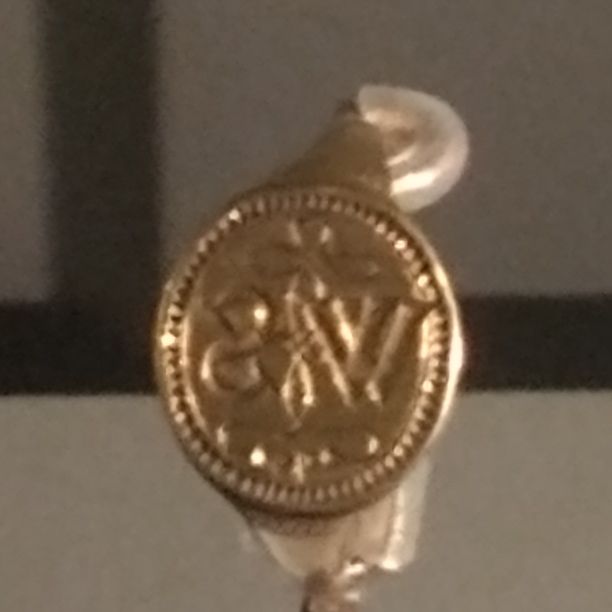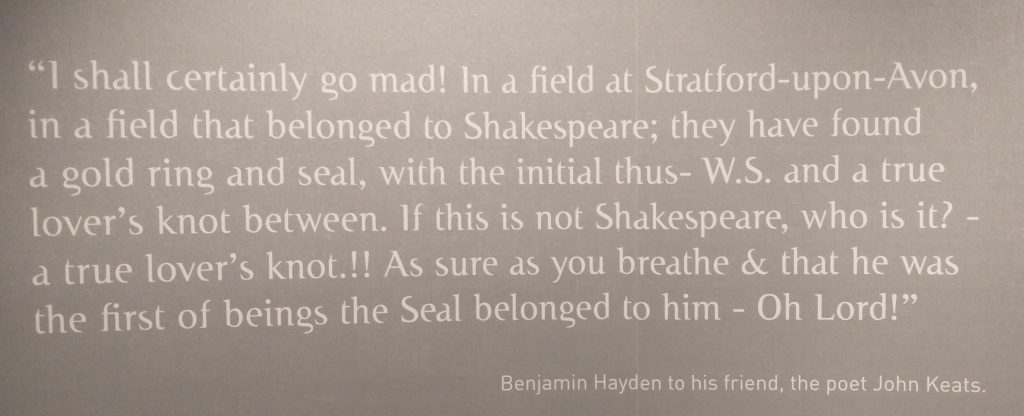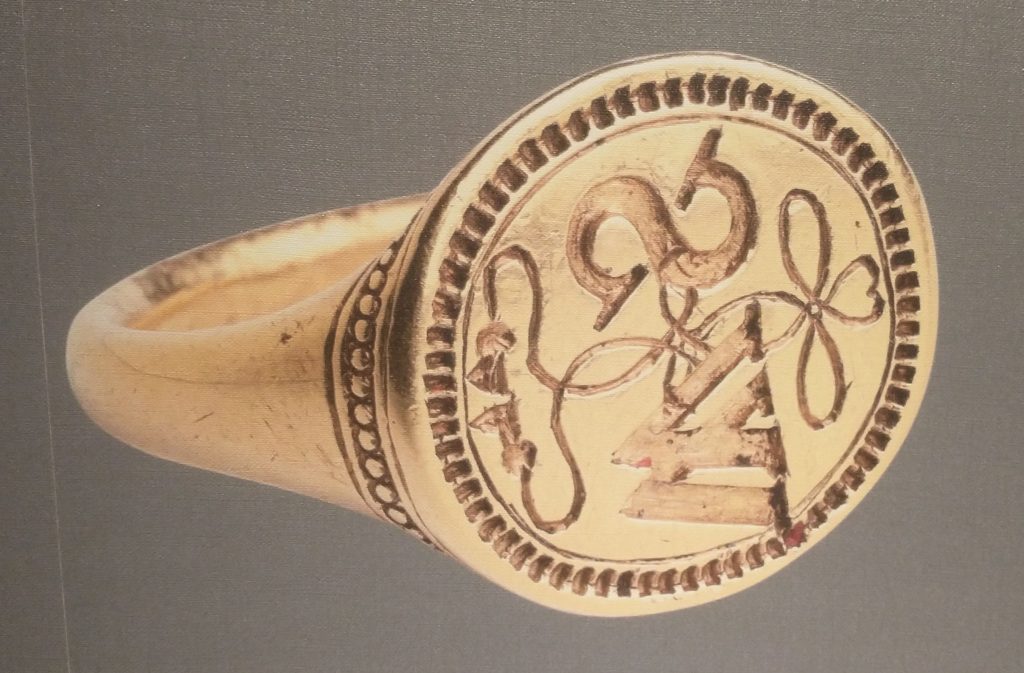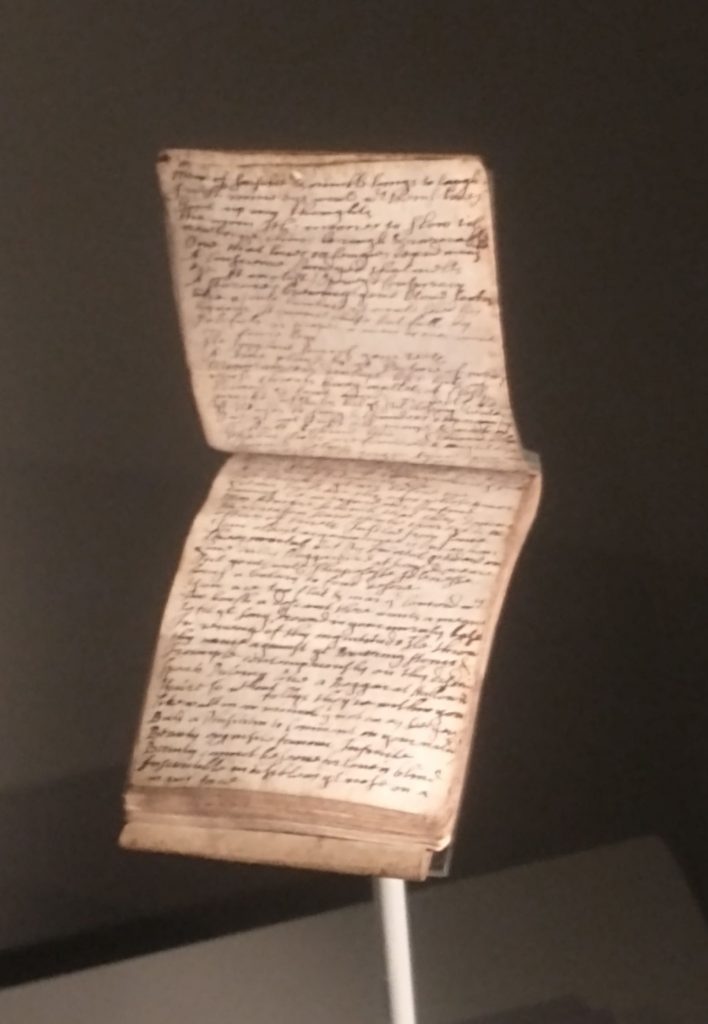
I went to New Place in Stratford-upon-Avon to see the First Folio Exhibition on the anniversary of its publication in 1623. It was a very small exhibition, and, at first sight quite disappointing. Almost everything in it I had seen before. But, I came away quite excited, because it had a much better explanation of the Signet Ring than the one in its previous display.
In 1810 someone found this gold ring in field near the Holy Trinity Church where Shakespeare was baptised and buried. It has a lover’s knot and the initials WS. It could ofcourse be anyone’s with those initials. But it certainly excited comment at the time as the display makes clear:

I did not know about the ring until New Place was refurbished a few years ago and the ring went on display. The new display gives more of an explanation as well as the delightful quotation above from Hayden to Keats.
Michael Wood suggested that Shakespeare might have lost the ring on the occassion of his daughter, Judith’s, marriage to Thomas Quiney in February 1616. Shakespeare made his Will a month later, and it is marked by three of his signatures. The Will says ‘whereof I have hereunto put my seale’. The word seale has been crossed out and the word ‘hand’ put in in its stead. So, he was intending to seale his approval of the Will, but changed his mind and put his signature instead? Why? Because he had recently lost his seal ring? Shakespeare died a month or so later.

Judith was the twin of Hamnet who died at age 11 and the Church has recently planted a couple of trees as a memorial to the twins, who are not buried, like their older sister, Suzanna, next to their mum and dad by the altar in the Church. Judith’s husband was a bit of a rogue, as he was called to the Bawdy Court and accused of debauchery with a local women who he made pregnant, and who died in childbirth. He is not mentioned in the Will.
But Shakespeare did leave money in his will to buy gold rings for his fellow actors, John Heminges and William Condell, who are buried in St Mary Aldermanbury in London. They outlived Shakespeare and collected his plays together in the First Folio. A Remembrance Ring is also in the display.

The other main item in the display is this tiny 7.8 cm high notebook in which its unknown owner copied out his favourite quotes from the First Folio. It contains material from all 38 plays, and internal evidence shows it must have been made from the First Folio. It is about the size of the minature books the Brontes made. The tiny writing of the book must have been written with a quill from a small bird.
The display shows that a lot can be made of a few objects, if they are well chosen and with an excellent explanation.
By the way the rings and the Folio are clear evidence that Shakespeare wrote the plays as his friends put together his plays in a volume with introductory information which makes it absolutely clear he wrote them. Also in the Church the memorial to Shakespeare compares him to King Nestor in judgement, Socrates in wisdom, and Virgil in art. Nothing can be clearer, and why people continue to say Shakespeare was simply an actor who copied out the plays is beyond me.

Discover more from And Did Those Feet
Subscribe to get the latest posts sent to your email.

Objects do bring back life to the past and people…
A great storyteller, you’re taking us with you on your exciting journey into Shakespeare’s life and story!
Thank you.
An interesting parallel between Shakespeare and Molière our most famous playwrights and authors.
French is referred as ‘la langue de Moliere’ and English as ‘la langue de Shakespeare’.
Moliere was born in 1622, so 6 years after Shakespeare’s death.
Molière’s authorship was also questioned at the beginning of the XXth century, on the basis of vocabulary similitudes with Corneille, his friend and playwright.
Computational liguistics settled the debate.
I had no idea anyone doubted Moliere.
Very interesting thanks Kevin, I didn’t know there was so much material linking to Shakespeare, I’m sure I read somewhere that the one genuine portrait of him in the National Portrait Gallery is the only evidence of him being a real person!!!
That’s how a conspiracy theory works. They normally say ‘there is a lot of evidence of Shakespeare the actor and absolutely none that he was a writer’. Which is ludicrous. Here are his friends, fellow actors putting together all his plays after his death and adding a picture, and a valedictory information from a fellow play write making it clear he is a writer. But the conspirators put a ludicrous interpretation on the words.
There are 2 well attested images, the one on his monument at Stratford and the one in the first folio.
The same liguistic analysis used to authentify Moliere’s authorship would indicate that Shakespeare’s last play, Henry VIII, written in 1613 and published in the first folio in 1623 under the title of ‘All is true’, was co-written with John Flecher.
John ‘Fletcher’
… according to Petr Plecháč, a Czech searcher (Computational stylistics in Poetry, Prose and Drama)
Shakespeare did a number of collaborations towards the end of his career, so quite likely! And with a regular set of actors in his company he must have collaborated with them.
I wrongly mentioned the title in the first Folio. ‘All is true’ was the title in contemporary documents …
Also the title of Kenneth Branaugh’s look at the last days of Shakespeare’s life.